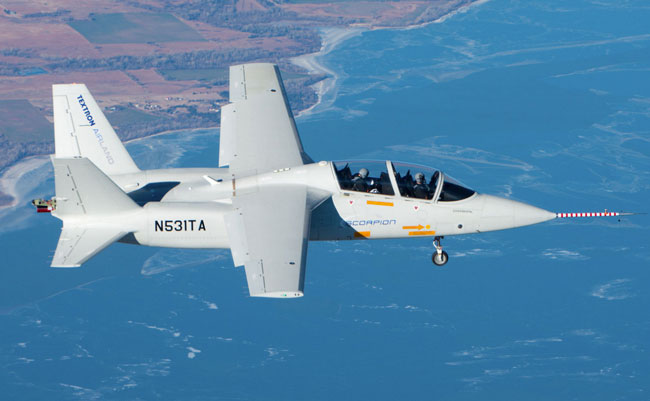Textron Air Land, LLC announced that the Scorpion Intelligence, Surveillance and Reconnaissance (ISR)/Strike aircraft developed and built by the company has completed its first flight at 10:30 AM Central Time on Thursday, December 12, 2013. The aircraft took off from McConnell Air Force Base in Wichita, Kansas and conducted a range of handling maneuvers for approximately 1.4 hours of flight. Today’s flight marks one of the fastest developments of a U.S.-built tactical jet, progressing from initial design to first flight in less than 24 months.

Scorpion’s first flight was crewed by pilot Dan Hinson, an engineering test pilot with over 5,000 flight hours in 79 different types of aircraft, and co-pilot David Sitz. “The flight was completed according to plan,” said Hinson. “Having flown many tactical aircraft throughout my 23-year career with the US Navy and with other aircraft manufacturers, I can say that the Scorpion compares very favorably to more costly aircraft currently used for low-threat missions. It showed impressive stability and responsiveness closely matching all of the predicted parameters for today’s maneuvers – it’s going to be a highly capable aircraft for the ISR and homeland security mission set.”
The Scorpion was announced in September 2013 as a demonstration aircraft designed to accommodate the budget constraints and shifting mission requirements of the U.S. Department of Defense and U.S. partner nations. Powered by twin turbofan engines generating 8,000 lbs. of thrust, the Scorpion transitions easily between low speed and high-subsonic speed, as needed for diverse missions such as irregular warfare, border patrol, maritime surveillance, emergency relief, counter-narcotics and air defense operations.
The Scorpion has a cruising speed of up to 450 ktas (517 mph), with a ferry range of 2,400 nautical miles. The aircraft carries an internal payload of up to 3,000 lbs., as well as wing-mounted precision munitions.
According to Stephen Trimble of Flightglobal, acquisition price of the Scorpion should be “well south” of $20 million. Trimble quoted Textron AirLand president Bill Anderson saying. Direct operating costs are targeted at $3,000 per hour, compared to $12,000 per hour for the Fairchild Republic A-10, he said. Anderson confirmed that given the modular design of the Scorpion, the two-seater platform could swap into a single-seater or an unmanned configuration, if required. Anderson said the company has already talked to two potential foreign buyers, as well as both active and reserve components of the US military. Trimble added the company hopes to complete up to 500 flight test hours over the next 12 months. The flights are aimed at clearing the basic speed and altitude envelope, culminating in a mission demonstration involving both sensor and weapons tests by the end of the year, says Scorpion chief engineer Dale Tutt.
“Today’s first flight is a major milestone for the Scorpion as the program transitions into the flight test phase,” commented Textron CEO Scott Donnelly. “When the design phase began less than two years ago, we were confident that we would deliver a uniquely affordable, versatile tactical aircraft by taking advantage of commercial aviation technologies and best practices. Today’s flight met all expectations, and keeps us on track towards certification and production,” Donnelly added.



















